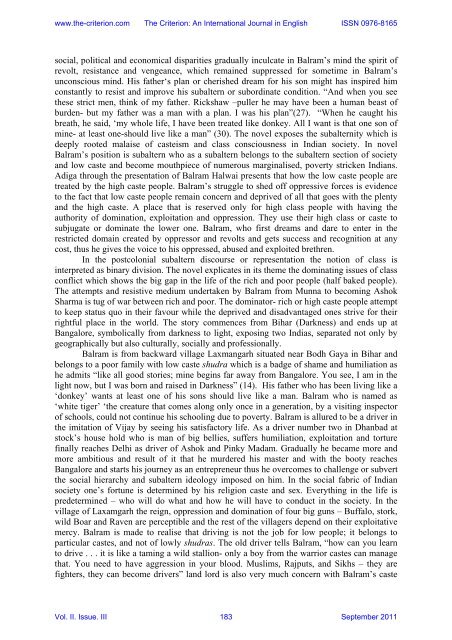Vol. II. Issue. III September 2011 - The Criterion: An International ...
Vol. II. Issue. III September 2011 - The Criterion: An International ...
Vol. II. Issue. III September 2011 - The Criterion: An International ...
Create successful ePaper yourself
Turn your PDF publications into a flip-book with our unique Google optimized e-Paper software.
www.the-criterion.com <strong>The</strong> <strong>Criterion</strong>: <strong>An</strong> <strong>International</strong> Journal in English ISSN 0976-8165<br />
social, political and economical disparities gradually inculcate in Balram’s mind the spirit of<br />
revolt, resistance and vengeance, which remained suppressed for sometime in Balram’s<br />
unconscious mind. His father‘s plan or cherished dream for his son might has inspired him<br />
constantly to resist and improve his subaltern or subordinate condition. “<strong>An</strong>d when you see<br />
these strict men, think of my father. Rickshaw –puller he may have been a human beast of<br />
burden- but my father was a man with a plan. I was his plan”(27). “When he caught his<br />
breath, he said, ‘my whole life, I have been treated like donkey. All I want is that one son of<br />
mine- at least one-should live like a man” (30). <strong>The</strong> novel exposes the subalternity which is<br />
deeply rooted malaise of casteism and class consciousness in Indian society. In novel<br />
Balram’s position is subaltern who as a subaltern belongs to the subaltern section of society<br />
and low caste and become mouthpiece of numerous marginalised, poverty stricken Indians.<br />
Adiga through the presentation of Balram Halwai presents that how the low caste people are<br />
treated by the high caste people. Balram’s struggle to shed off oppressive forces is evidence<br />
to the fact that low caste people remain concern and deprived of all that goes with the plenty<br />
and the high caste. A place that is reserved only for high class people with having the<br />
authority of domination, exploitation and oppression. <strong>The</strong>y use their high class or caste to<br />
subjugate or dominate the lower one. Balram, who first dreams and dare to enter in the<br />
restricted domain created by oppressor and revolts and gets success and recognition at any<br />
cost, thus he gives the voice to his oppressed, abused and exploited brethren.<br />
In the postcolonial subaltern discourse or representation the notion of class is<br />
interpreted as binary division. <strong>The</strong> novel explicates in its theme the dominating issues of class<br />
conflict which shows the big gap in the life of the rich and poor people (half baked people).<br />
<strong>The</strong> attempts and resistive medium undertaken by Balram from Munna to becoming Ashok<br />
Sharma is tug of war between rich and poor. <strong>The</strong> dominator- rich or high caste people attempt<br />
to keep status quo in their favour while the deprived and disadvantaged ones strive for their<br />
rightful place in the world. <strong>The</strong> story commences from Bihar (Darkness) and ends up at<br />
Bangalore, symbolically from darkness to light, exposing two Indias, separated not only by<br />
geographically but also culturally, socially and professionally.<br />
Balram is from backward village Laxmangarh situated near Bodh Gaya in Bihar and<br />
belongs to a poor family with low caste shudra which is a badge of shame and humiliation as<br />
he admits “like all good stories; mine begins far away from Bangalore. You see, I am in the<br />
light now, but I was born and raised in Darkness” (14). His father who has been living like a<br />
‘donkey’ wants at least one of his sons should live like a man. Balram who is named as<br />
‘white tiger’ ‘the creature that comes along only once in a generation, by a visiting inspector<br />
of schools, could not continue his schooling due to poverty. Balram is allured to be a driver in<br />
the imitation of Vijay by seeing his satisfactory life. As a driver number two in Dhanbad at<br />
stock’s house hold who is man of big bellies, suffers humiliation, exploitation and torture<br />
finally reaches Delhi as driver of Ashok and Pinky Madam. Gradually he became more and<br />
more ambitious and result of it that he murdered his master and with the booty reaches<br />
Bangalore and starts his journey as an entrepreneur thus he overcomes to challenge or subvert<br />
the social hierarchy and subaltern ideology imposed on him. In the social fabric of Indian<br />
society one’s fortune is determined by his religion caste and sex. Everything in the life is<br />
predetermined – who will do what and how he will have to conduct in the society. In the<br />
village of Laxamgarh the reign, oppression and domination of four big guns – Buffalo, stork,<br />
wild Boar and Raven are perceptible and the rest of the villagers depend on their exploitative<br />
mercy. Balram is made to realise that driving is not the job for low people; it belongs to<br />
particular castes, and not of lowly shudras. <strong>The</strong> old driver tells Balram, “how can you learn<br />
to drive . . . it is like a taming a wild stallion- only a boy from the warrior castes can manage<br />
that. You need to have aggression in your blood. Muslims, Rajputs, and Sikhs – they are<br />
fighters, they can become drivers” land lord is also very much concern with Balram’s caste<br />
<strong>Vol</strong>. <strong>II</strong>. <strong>Issue</strong>. <strong>II</strong>I 183 <strong>September</strong> <strong>2011</strong>
















